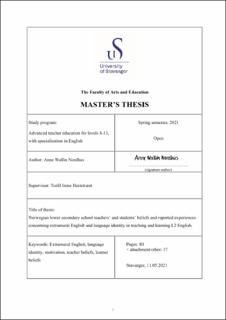| dc.description.abstract | This thesis aimed to explore Norwegian lower secondary school teachers’ and students’ beliefs and reported experiences concerning extramural English (EE) and language identity. The study placed a significant emphasis on describing and comparing their beliefs to previous theory on these topics. This was done in order to shed light on how EE and language identity are factors to be considered in teachers’ classroom practice.
To gather the data, a qualitative research method was employed, which included semi-structured interviews. Four teachers in both the 9th and the 10th grade and six students in the 10th grade in two lower secondary schools in Norway were interviewed. The data was then transcribed, coded and analyzed using content analysis.
The findings revealed that teachers and students are heavily exposed to English outside of school by participating in EE activities such as watching TV, playing video games and using social media. Overall, they seemed to primarily use EE receptively (e.g. listening and reading). The teachers and students believed that EE activities can contribute to language development. However, it seemed that EE can only accommodate students’ language development to a certain extent. The students reported a need to practice their productive skills in school, such as written and spoken skills. Therefore, it may be essential to practice a variety of skills in school.
The majority of the teachers and students identified with the English language. Whereas the teachers attempted to avoid code-switching, the students code-switched to a large extent. Their large use of code-switching was seen to be reflected through their extensive familiarity with English. Students’ choice of pronunciation was mostly influenced by native speakers and EE activities.
As for students’ motivation and investment in L2 English, it was important for them to understand and to be understood. The students reported that both internal and external factors motivated them to develop their L2 skills. This was in line with the teachers’ beliefs about their students’ motivation. The activities students found most motivating were communicative tasks. The teachers reported that they taught more content, which may be seen as a shift from a focus on teaching language skills, to teaching content, in Norwegian classrooms.
This study contributes to previous research of L2 English by studying both teachers’ and students’ beliefs concerning EE and language identity. It provides knowledge of teachers’ and students’ beliefs, which can be valuable for teachers in continuing to engage and motivate their students in the L2 English classroom, in the context of EE and language identity. | |
